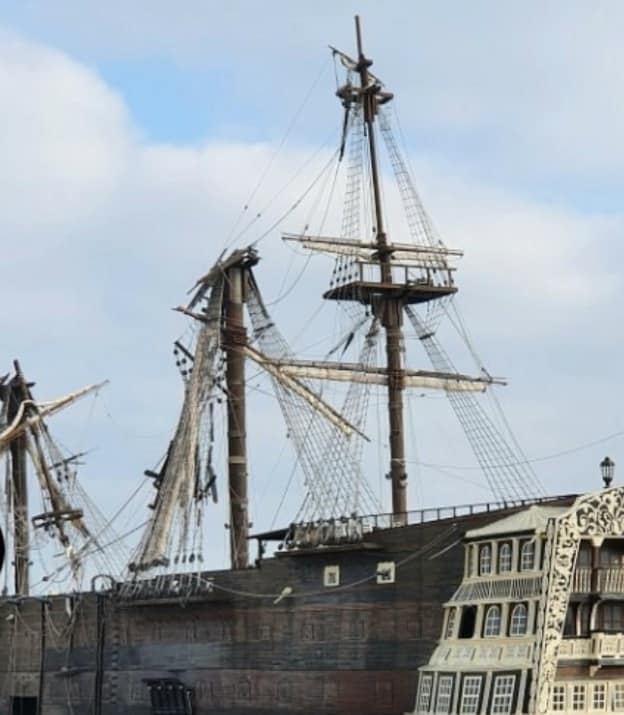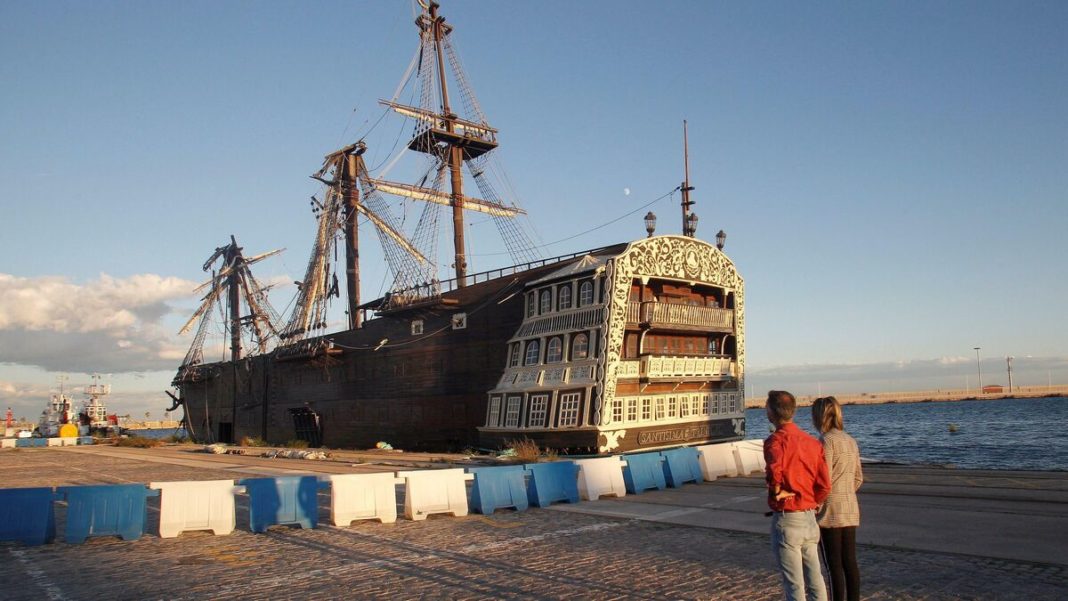- By Andrew Atkinson in Alicante where the Galleon Santísima Trinidad remains hidden from public view having been formerly moored in Alicante harbour, near to the casino, with two damaged masts.
The replica ship of Nuestra Señora de la Santísima Trinidad is now unaccessable to the public, having been moved away from the port.
Santísima Trinidad – officially named Nuestra Señora de la Santísima Trinidad by Royal Order on 12 March 1768, nicknamed La Real.
At times confused with the galleon Santísima Trinidad y Nuestra Señora del Buen Fin – was a Spanish ship with 112 guns, increased in 1795–96 to 130 guns by closing in the spar deck between the quarterdeck and forecastle, and to 140 guns around 1802.
It created a continuous fourth gundeck, being the heaviest-armed ship in the world when rebuilt, and bore the most guns of any ship of the line outfitted in the Age of Sail.
After a hard and heroic struggle, it was captured by the English in a very poor condition, with over 200 dead and 100 wounded.
The British worked hard to save the ship and brought her to the British port of Gibraltar, towed by the frigate HMS Phoebe and HMS Naiades.
The Santísima Trinidad, a ‘Ghost ship’ was moored in the Port of Alicante, while waiting for its transfer to Cape Verde.
Today the deterioration is evident, with damage to two masts.

It is understood the company that acquired the ship has not completed all the documentation to transfer it to Cape Verde.
It is in situ as a ghostly image, anchored in the dock of the Port, and was a shadow overlooked by the £788m cruiseliner Iona that docked in Alicante in November.
The deterioration is evident from distance with the wooden structures rotting.
It is reported the Port collects the fees from the company that continues to carry out arrangements for the transfer with plans for transportation, finalising details on security and permits, according to the Port Authority.
The Alicante Port Authority awarded the replica of the Santísima Trinidad to a tourism company, specialised in luxury travel, which plans to move the floating platform to the Republic of Cape Verde.
The successful auction bidder had an initial reported period of two months, expandable to eight, to carry out essential basic repairs and obtain necessary permits, to be able to carry out its transfer to the African country.
The journey to its next destination, of approximately 2,000 nautical miles, will be propelled by a tugboat, and once there it would be thoroughly conditioned by a shipyard, to continue its use as a restaurant and nightclub.
The ship was purchased by a company in Benidorm to anchor it in the tourist capital, but after paying a deposit, the society did not continue with the procedures, so the bidding was void.
Thereafter a merchant wanted to buy it for scrapping, but did not obtain the necessary permits, and the issue once again remained at a standstill.
In order for the Captaincy to authorise its activity, it must first pass an inspection in a dry dock, entailing a trailer up to Cartagena or Dénia, along with actions required by the Captaincy after the inspection, an economically unviable process, unless it then operates in one of those ports.
The Santísima Trinidad was the flagship of the Spanish Navy in the 18th century equipped with 112 guns, the ship was the largest of the time active in all the Spanish battles from 1769 until in Trafalgar, in 1805, after which it ended sinking, due to damage suffered.
The nautical artifact must pass an inspection in a dry dock before returning to host any activity in its interior and this entails a trailer to Dénia, where these works will be carried out for the tuning of the Santísima Trinidad.
The replica ship suffered a series of damages during its transfer which, together with the reported carelessness of its previous owner, required an examination.
Once carried out, the ship will be able to set course for its new destination.





